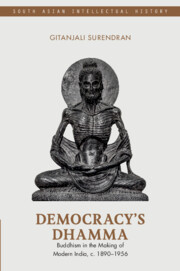Book contents
- Frontmatter
- Dedication
- Contents
- List of Figures
- Acknowledgements
- List of Abbreviations
- Introduction: Buddhism in the Making of Modern India
- 1 Anagarika Dharmapala in India
- 2 Dharmapala and Vivekananda in an Age of Universalism
- 3 Buddhism and The Bhadralok
- 4 The Buddhist Bay: Buddhist Mobility Across the Bay of Bengal
- 5 Buddhist Relics, The Mahabodhi Temple and The Discourse of a Shared Buddhism
- 6 Buddhism as a Civil Religion and Hindutva
- 7 Buddhism, Anti-Caste Radicalism and Socialism
- 8 Ambedkar, Dhamma and Democracy
- Conclusion: The Destinies of Buddhism
- Bibliography
- Index
1 - Anagarika Dharmapala in India
Published online by Cambridge University Press: 28 November 2024
- Frontmatter
- Dedication
- Contents
- List of Figures
- Acknowledgements
- List of Abbreviations
- Introduction: Buddhism in the Making of Modern India
- 1 Anagarika Dharmapala in India
- 2 Dharmapala and Vivekananda in an Age of Universalism
- 3 Buddhism and The Bhadralok
- 4 The Buddhist Bay: Buddhist Mobility Across the Bay of Bengal
- 5 Buddhist Relics, The Mahabodhi Temple and The Discourse of a Shared Buddhism
- 6 Buddhism as a Civil Religion and Hindutva
- 7 Buddhism, Anti-Caste Radicalism and Socialism
- 8 Ambedkar, Dhamma and Democracy
- Conclusion: The Destinies of Buddhism
- Bibliography
- Index
Summary
RETHINKING ANAGARIKA DHARMAPALA IN SOUTH ASIA
On a chilly day in late January 1891, a young man from Ceylon who came to be known as Anagarika Dharmapala had an epiphany while on pilgrimage at the Mahabodhi temple at Bodh Gaya. It was at this spot that the Gautama Buddha is said to have attained Enlightenment while meditating under a peepul tree in the 6th century BCE. Since at least the 18th century, the Mahabodhi temple had been inhabited and maintained by a Saivite Giri matha (monastery) under the leadership of their mahant (chief monk) and became part of Gaya's Hindu ritual circuit. In early 1891, Dharmapala made the arduous trip to Gaya along with a Japanese Theravada monk, Kozen Gunaratna. Dharmapala described the moment in his diary,
As soon as I touched with my forehead the Vajrasana a sudden impulse came to my mind. It prompted me to stop here and take care of this sacred spot—so sacred that nothing in the world is equal to this place where Prince Sakya Sinha gained enlightenment under the Bodhi tree.
The narrative that the Mahabodhi temple needed to be saved and cared for by Buddhists and that it was essentially if not exclusively a Buddhist site had been put into motion with the publication of Sir Edwin Arnold's essay on Bodh Gaya in 1885 in the Daily Telegraph and the many colonial archaeological investigations of Buddhist sites during the 19th century. Even Dharmapala's epiphany to this effect was not unique to him. Around the same time, Kripasaran Mahathera, the soon-to-be founder of the Bauddha Dharmankur Sabha (Bengal Buddhist Association), visited the site and came to the same realization—that both Buddhism and the site needed saving and that these tasks would require, at the very least, his complete dedication to the cause.
This is not to say that there was nothing original about Dharmapala's epiphany at the Mahabodhi temple and his subsequent Buddhist activism. Dharmapala's labours in the arena of equating a ‘revived’ and ‘reformed’ Buddhism with Sinhala identity had lasting effects in modern Sri Lanka. He is best remembered there as a Sinhala nationalist and a figurehead of the Sinhala exclusivist movement that took off in the 1950s.
- Type
- Chapter
- Information
- Democracy's DhammaBuddhism in the Making of Modern India, c. 1890–1956, pp. 16 - 50Publisher: Cambridge University PressPrint publication year: 2025

